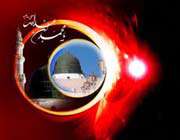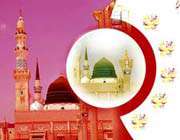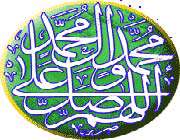The Prophet of Islam And Arabia (Part 1)
| This article is in two parts. The 2nd part is: The Prophet of Islam And Arabia (Part 2). Please Click here for Part 2. Author: Mohammad Hamidullah
|
A perusal of the map of the major hemisphere (from the point of view of the proportion of land to sea), shows the Arabian Peninsula lying at the confluence of the three great continents of Asia, Africa and Europe. At the time in question this extensive Arabian subcontinent composed mostly of desert areas was inhabited by people of settled habitations as well as nomads. Often it was found that members of the same tribe were divided into these two groups, and that they preserved a relationship although following different modes of life. The means of subsistence in Arabia were meagre. The desert had its handicaps, and trade caravans were features of greater importance than either agriculture or industry. This entailed much travel, and men had to proceed beyond the peninsula to Syria, Egypt, Abyssinia, Iraq, Sind, India and other lands.
We do not know much about the Libyanites of Central Arabia, but Yemen was rightly calledArabia Felix. Having once been the seat of the flourishing civilizations of Sheba and Ma"in even before the foundation of the city of Rome had been laid, and having later snatched from the Byzantians and Persians several provinces, greater Yemen which had passed through the hey-day of its existence, was however at this time broken up into innumerable principalities, and even occupied in part by foreign invaders. The Sassanians of Iran, who had penetrated into Yemen had already obtained possession of Eastern Arabia. There was politico-social chaos at the capital (Mada"in = Ctesiphon), and this found reflection in all her territories. Northern Arabia had succumbed to Byzantine influences, and was faced with its own particular problems. Only Central Arabia remained immune from the demoralising effects of foreign occupation.
In this limited area of Central Arabia, the existence of the triangle of Mecca-Ta"if-Madinah seemed something providential. Mecca, desertic, deprived of water and the amenities of agriculture in physical features represented Africa and the burning Sahara. Scarcely fifty miles from there, Ta"if presented a picture of Europe and its frost. Madinah in the North was not less fertile than even the most temperate of Asiatic countries like Syria. If climate has any influence on human character, this triangle standing in the middle of the major hemisphere was, more than any other region of the earth, a miniature reproduction of the entire world. And here was born a descendant of the Babylonian Abraham, and the Egyptian Hagar, Muhammad the Prophet of Islam, a Meccan by origin and yet with stock related, both to Madinah and Ta"if.

From the point of view of religion, Arabia was idolatrous; only a few individuals had embraced religions like Christianity, Mazdaism, etc. The Meccans did possess the notion of the One God, but they believed also that idols had the power to intercede with Him. Curiously enough, they did not believe in the Resurrection and Afterlife. They had preserved the rite of the pilgrimage to the House of the One God, the Ka"bah, an institution set up under divine inspiration by their ancestor Abraham, yet the two thousand years that separated them from Abraham had caused to degenerate this pilgrimage into the spectacle of a commercial fair and an occasion of senseless idolatry which far from producing any good, only served to ruin their individual behaviour, both social and spiritual.
In spite of the comparative poverty in natural resources, Mecca was the most developed of the three points of the triangle. Of the three, Mecca alone had a city-state, governed by a council of ten hereditary chiefs who enjoyed a clear division of power. (There was a minister of foreign relations, a minister guardian of the temple, a minister of oracles, a minister guardian of offerings to the temple, one to determine the torts and the damages payable, another in charge of the municipal council or parliament to enforce the decisions of the ministries. There were also ministers in charge of military affairs like custodianship of the flag, leadership of the cavalry etc.). As well reputed caravan-leaders, the Meccans were able to obtain permission from neighbouring empires like Iran, Byzantium and Abyssinia - and to enter into agreements with the tribes that lined the routes traversed by the caravans - to visit their countries and transact import and export business. They also provided escorts to foreigners when they passed through their country as well as the territory of allied tribes, in Arabia (cf. Ibn Habib,Muhabbar). Although not interested much in the preservation of ideas and records in writing, they passionately cultivated arts and letters like poetry, oratory discourses and folk tales. Women were generally well treated, they enjoyed the privilege of possessing property in their own right, they gave their consent to marriage contracts, in which they could even add the condition of reserving their right to divorce their husbands. They could remarry when widowed or divorced. Burying girls alive did exist in certain classes, but that was rare.
4. Birth of the Prophet 
It was in the midst of such conditions and environments that Muhammad was born in 569 after Christ. His father, "Abdullah had died some weeks earlier, and it was his grandfather who took him in charge. According to the prevailing custom, the child was entrusted to a Bedouin foster-mother, with whom he passed several years in the desert. All biographers state that the infant prophet sucked only one breast of his foster-mother, leaving the other for the sustenance of his foster-brother. When the child was brought back home, his mother, Aminah, took him to his maternal uncles at Madinah to visit the tomb of "Abdullah. During the return journey, he lost his mother who died a sudden death. At Mecca, another bereavement awaited him, in the death of his affectionate grandfather. Subjected to such privations, he was at the age of eight, consigned at last to the care of his uncle, Abu-Talib, a man who was generous of nature but always short of resources and hardly able to provide for his family.
Young Muhammad had therefore to start immediately to earn his livelihood; he served as a shepherd boy to some neighbours. At the age of ten he accompanied his uncle to Syria when he was leading a caravan there. No other travels of Abu-Talib are mentioned, but there are references to his having set up a shop in Mecca. (Ibn Qutaibah,Ma"arif). It is possible that Muhammad helped him in this enterprise also.

By the time he was twenty-five, Muhammad had become well known in the city for the integrity of his disposition and the honesty of his character. A rich widow, Khadijah, took him in her employ and consigned to him her goods to be taken for sale to Syria. Delighted with the unusual profits she obtained as also by the personal charms of her agent, she offered him her hand. According to divergent reports, she was either 28 or 40 years of age at that time, (medical reasons prefer the age of 28 since she gave birth to five more children). The union proved happy. Later, we see him sometimes in the fair of Hubashah (Yemen), and at least once in the country of the "Abd al-Qais (Bahrain-Oman), as mentioned by Ibn Hanbal. There is every reason to believe that this refers to the great fair of Daba (Oman), where, according to Ibn al-Kalbi (cf. Ibn Habib,Muhabbar), the traders of China, of Hind and Sind (India, Pakistan), of Persia, of the East and the West assembled every year, travelling both by land and sea. There is also mention of a commercial partner of Muhammad at Mecca. This person, Sa"ib by name reports: "We relayed each other; if Muhammad led the caravan, he did not enter his house on his return to Mecca without clearing accounts with me; and if I led the caravan, he would on my return enquire about my welfare and speak nothing about his own capital entrusted to me."
The continuation of this article is: The Prophet of Islam And Arabia (Part 2). Please Click here for PART 2.
Other Useful Links: Historian views about Arabia and Prophet of Islam (P.B.U.H) Muhammad (S.A.W.) The Most Influential Person in History The Intellectual and Spiritual Personality of the Greatest Prophet Life and Teaching Of Prophet Of Islam The Last and Final Messenger of God The Prophet of Islam And Arabia (Part 2) The Last Message the Last Prophet The Complete Life of the Prophet Muhammad Prophet Muhammad’s Hadith A Brief History of the Prophet's Life
Useful Ziyaraat Links: Ziyaraat of Prophet Mohammad(S.A.W) Inside Shrine Ziyaraat of Prophet Mohammad(S.W.A) from distance The Manner of Entering Holy Prophet Muhammad(S.A) Shrine